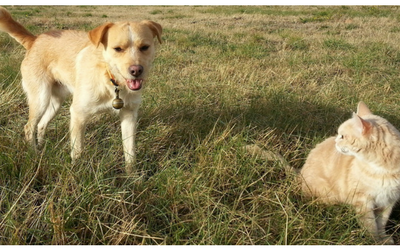
Everyday cats and dogs wander away from home, or get loose. Animal shelters are tasked with finding and reuniting these pets with their owners. Only a small number of pets that arrive at shelters have ID tags or are microchipped. Without this identification, it makes reuniting these pets with their families difficult.
Your pet can be identified in a few ways:
1) Microchipping
A microchip is a tiny transponder, about the size of a grain of rice, encoded with a unique identification number. This identification number is registered into a database with your pet’s details and your contact information.
If your pet gets lost and is taken to a veterinary clinic or animal shelter, your pet will be scanned for a microchip to reveal his unique ID number. That number will be called into the pet recovery service, and you will be contacted using the contact information on file with your pet’s microchip.
2) Tags
Identification tags on your pet’s collar are another means to identify your pet.
Many cities require licensing of dogs and sometimes cats. The city then issues a tag with a unique identification number on it. If your pet is lost, this number can be entered into the city’s system and you will be contacted using the information provided when you registered your pet.
Vaccination tags are sometimes provided by veterinary clinics when your pet is vaccinated. These tags also have a unique identification number on them. If the veterinary clinic is contacted when a pet is found, the number will be matched with your contact information.
Specially customized tags can be purchased with your address and telephone number. If your pet is found, this information will be used to contact you directly.
Keep in mind that collars can fall off, tags can be pulled off, or can become worn down, making it difficult or impossible to read the tag
3) Tattoos
Sometimes tattoos are used as an identification tool. The tattoo is again a unique code that contains information about the pet and owner. Over time, tattoos can become unreadable, fade, or become obscured by hair. Unfortunately there is no common database for the information, so reuniting pets using tattoos is difficult.
Bottom Line
Even indoor pets need tags and microchips. Many stray cats and dogs that turn up at shelters are indoor pets that have escaped. Ensure that your indoor cat or dog is wearing a collar with an ID tag containing up-to-date information and consider microchipping.
If you move or get a new phone number, don’t forget to update your contact information associated with the ID tag or microchip. When travelling with your pets, make sure that the ID tag has a phone number of someone who knows how to reach you or better yet, use your cell phone number on the tag.
A lost pet causes a lot of worry for a family. While microchipping doesn’t guarantee a happy reunion, studies have shown that pets with microchips are reunited with their families at a much higher rate than those pets without microchips. Consider microchipping as another means to identify your furry friend should he wander away and become lost.

